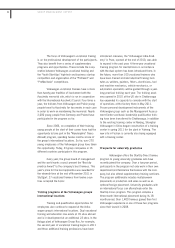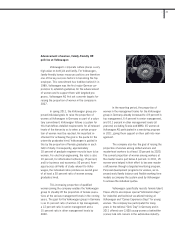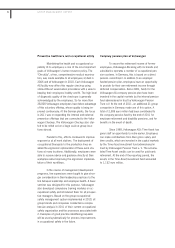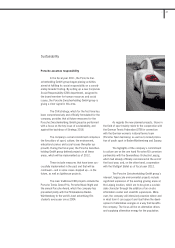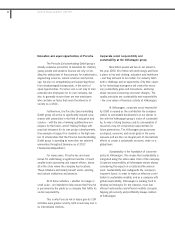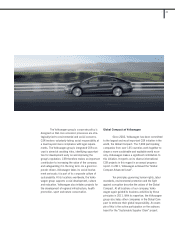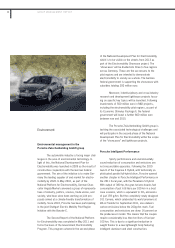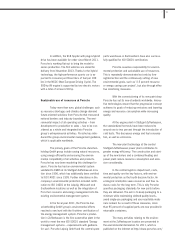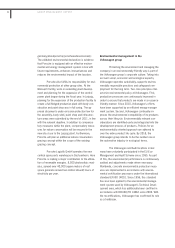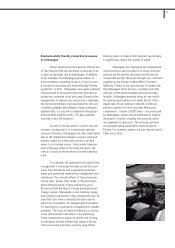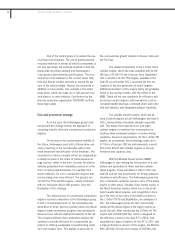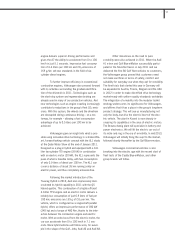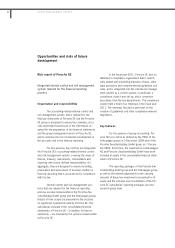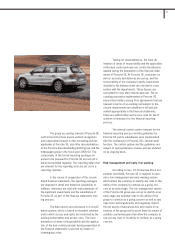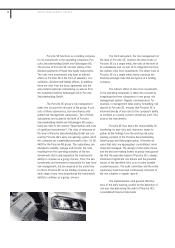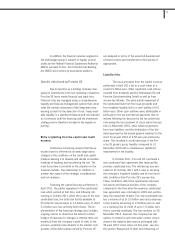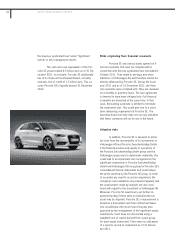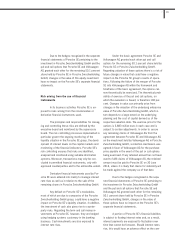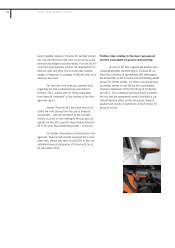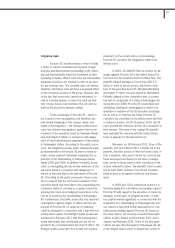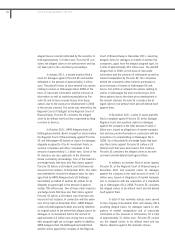Porsche 2011 Annual Report Download - page 94
Download and view the complete annual report
Please find page 94 of the 2011 Porsche annual report below. You can navigate through the pages in the report by either clicking on the pages listed below, or by using the keyword search tool below to find specific information within the annual report.
One of the central goals is to reduce the use
of primary raw materials. The use of quality-assured
recycled materials in almost all vehicle components is
not only permitted, but explicitly required in both the
group-wide recycling standard and Volkswagen's
cross-project environmental specifications. The recy-
cled share of all materials in the current series Golf,
Polo and Sharan models amounts to around 40 per-
cent of the vehicle weight. Plastics are recovered in
addition to many metals. One example is the under-
body shells, which are made up of 100 percent recy-
cled plastics in some vehicles. Certification by the
German inspection organization TÜV NORD confirms
these high values.
Fuel and powertrain strategy
As in the past, the Volkswagen group’s fuel
and powertrain strategy follows the approach of
coexisting electric drive and conventional combustion
engines.
On the way to the carbon-neutral mobility of
the future, Volkswagen sees both of these drive con-
cepts coexisting in the next decades with a clear
trend toward the electrification of the drivetrain. This
coexistence of drive concepts will be accompanied by
a steady increase in the share of carbon-neutral en-
ergy sources, either in the form of power for electric
vehicles generated from renewable sources or in the
form of carbon-neutral biofuels, for example from
waste materials, for use in combustion engines that
are becoming ever more efficient. The group’s suc-
cessful TSI, TFSI and TDI engines, ideally combined
with our innovative direct shift gearbox, form the
foundation of this strategy.
The enhancement of conventional combustion
engines reached a milestone at the Volkswagen group
in 2011. Development work on the completely new
generation of three- and four-cylinder petrol and diesel
engines made tremendous progress and achieved its
latest success with the market introduction of the up!.
The company believes that combustion engines will
continue to provide the basis for a responsible ap-
proach to offering sustainable, forward-looking mobil-
ity in the medium term. This applies in particular to
the cost-sensitive growth markets in Russia, India and
the Far East.
The market introduction of the 1.0 liter three-
cylinder engine, which has been available with 44 kW
(60 hp) or 55 kW (75 hp) in the up! since September
2011, and the 1.8 liter TFSI engine, available in the
Audi A5 since October 2011, launched the first de-
rivatives of the new generation of petrol engines.
Additional members of this engine family will gradually
follow in the coming months, with the rollout of the
MQB. These will set new standards for efficiency and
economy in petrol engines, with innovations such as
camshaft needle bearings, combined direct and mani-
fold fuel injection, and integrated exhaust manifolds.
The cylinder shutoff system, which will be
used in petrol engines at both Volkswagen and Audi in
2012, demonstrates innovative strength especially
well. This allows the respective four- and eight-
cylinder engines to optimize fuel consumption by
shutting down unneeded cylinders in certain driving
situations, based on requirements. On the 1.4-liter TSI
engine, as an example, this technology saves up to
0.7 liters of fuel per 100 km and represents a world
first in the field of four-cylinder engines in this per-
formance and capacity class.
With the Modular Diesel System (MDB),
Volkswagen is also nearing the introduction of a com-
pletely new generation of three- and four-cylinder
diesel engines. These will debut in 2012 in the new
Audi A3 and set new benchmarks for driving pleasure,
cleanliness and efficiency. The Volkswagen group has
also continued to write the success story of the diesel
engine in other areas. Steadily rising market shares in
the North American market, which has a critical atti-
tude towards diesel engines, and recognition in Euro-
pe in the form of five stars in the ADAC ecoTest for
the 1.6-liter TDI Passat BlueMotion, are examples of
this. The Volkswagen group has also successfully
advanced the diesel engine in the higher engine ca-
pacity classes. After introducing the 3.0-liter V6 TDI
engine with 150 kW (204 hp), which is designed as
the efficiency version in the Audi A7 in 2010, Audi
expanded its range of engines for the A7 in 2011 with
a high-performance version of this engine, the BiTurbo.
With 230 kW (313 hp) and a torque of 650 Nm, this
GROUP MANAGEMENT REPORT94


